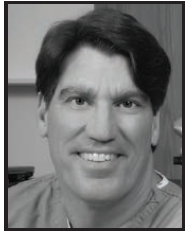




The following article highlights key questions addressed during a roundtable discussion of the role of personalized CONTOURA Vision topography-guided LASIK among today’s selection of refractive treatments. Led by Kerry D. Solomon, MD, the panel included Daniel S. Durrie, MD; Ronald R. Krueger, MD; Karl G. Stonecipher, MD; and R. Doyle Stulting, MD, PhD.
Who are the best candidates for successful CONTOURA Vision topography-guided treatment? Specifically, what clinical characteristics should surgeons look for as they start doing their first procedures?
R. Doyle Stulting, MD: During the CONTOURA Vision (Alcon) clinical trial in the United States, we were restricted to normal eyes with myopia and myopic astigmatism, so the approval and labeling are for normal eyes only.1 That excludes previous refractive surgery, including LASIK, PRK or RK; abnormal corneas such as those with keratoconus; and any other abnormal features such as asymmetrical bowties or skewed radial axes. I recommend that surgeons new to the procedure choose candidates for whom they would feel comfortable performing WAVEFRONT OPTIMIZED ablation, who also have good topographies.
Karl G. Stonecipher, MD: To select candidates for a procedure using any new technology, we have to start with the indication. In this case, CONTOURA Vision is indicated for patients with up to -9.00 D of myopia or patients who have myopic astigmatism, up to -8.00 D of myopia and up to 3.00 D of astigmatism.
I recommend that surgeons new to the procedure start performing CONTOURA Vision with patients who have 1.00 D or less of astigmatism, as well as myopia of -4.00 D or less. When we look at our overall outcomes, these patients tend to have our best outcomes.
This is CONTOURA Vision topography-guided ablation. Can you talk about how topographies help you identify candidates for CONTOURA Vision? Does that differ at all from wavefront candidates?
Kerry D. Solomon, MD: Because CONTOURA Vision addresses corneal irregularities instead of the collective aberrations neutralized by wavefront, it is an excellent option when it is difficult to acquire wavefront measurements, but topography is accurate and shows significant corneal aberrations. After surgery, these patients can have clear corneas, in addition to fewer induced aberrations,2,3 uncorrected distance vision better than best spectacle-corrected vision before surgery, and improved visual symptoms.1,4
Daniel S. Durrie, MD: I would say that the best candidates for CONTOURA Vision are patients for whom you can get absolutely perfect topography. That is where you want to start. Patients who have a prominent brow or nose obstructing the reflection and preventing you from acquiring the data are not good candidates for CONTOURA Vision. You want to be very careful to make sure that the measurements guiding the procedure are highly accurate—if not, I imagine the outcomes could be equally problematic. As they say, “garbage in, garbage out.” However, if we use CONTOURA Vision on label, with healthy, nondry eyes, the data show that our patients will do extremely well.
Ronald R. Krueger, MD: I agree. If we make sure to acquire accurate data before surgery, then, in my experience, we will get good outcomes comparable to or better than the clinical study. Surgeons see the clinical study results and get excited about this procedure. It shows at 1 year that 93% of eyes achieved 20/20 or better UCVA, with nearly two-thirds seeing 20/16 and one-third seeing 20/12.5. Also, more than 30% gained one or more lines of UCVA compared to their best preoperative acuity.1 If we want to get outcomes like those achieved in the clinical study, we need to follow the same guidelines, which include meticulous topographies, multiple images (at least four to eight per eye), and good coordination of data.
I think that surgeons who are new to CONTOURA Vision should look for previously untreated eyes that have mildly irregular topographies with consistent refractive and topographic astigmatism. Those will be perfect cases, where the small topographic irregularities can be treated to achieve the best possible vision.
If a patient is in the indicated range of myopia astigmatism and has highly accurate topography, what additional characteristics should surgeons seek or avoid in a potential CONTOURA Vision candidate?
Dr. Stonecipher: One thing we noted when we evaluated patients for CONTOURA Vision is that a typical dry eye patient may be harder to measure. In fact, you may not be able to get a good topography for these patients, which disqualifies them from the procedure. We cannot base a procedure on inaccurate measurements. Like Dr. Durrie, I think that deep-set eyes also present a challenge for topography, making them another disqualifying factor for some patients. I just explain that I cannot get a good measurement and why, and we choose another option.
Dr. Krueger: Like Dr. Stonecipher, I consider ocular surface disease to be an important factor, which can either contraindicate the procedure or lead to preoperative treatment so as to get the most accurate topographic measurements. The resulting accurate topographies ultimately lead to the best results.
1. Stulting RD, Fant BS; T-CAT Study Group. Results of topography-guided laser in situ keratomileusis custom ablation treatment with a refractive excimer laser. J Cataract Refract Surg. 2016;42(1):11-18.
2. Shetty R, Shroff R, Deshpande K, et al. A prospective study to compare visual outcomes between wavefront optimized and topography- guided ablation profiles in contralateral eyes with myopia. J Refract Surg. 2017;33(1):6-10.
3. Jain AK, Malhotra C, Pasari A, et al. Outcomes of topography-guided versus wavefront optimized laser in situ keratomileusis for myopia in virgin eyes. J Cataract Refract Surg. 2016;42(9):1302-1311.
4. Sugar A, Hood CT, Mian SI. Patient-reported outcomes following LASIK: Quality of life in the PROWL studies. JAMA. 2017;317(2):204-205.
Important Product Information